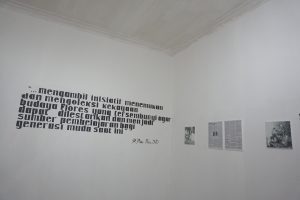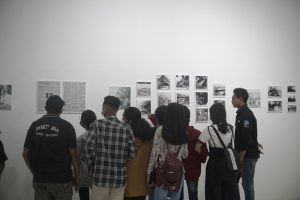The idea for the exhibition titled R-IBB was born from the anxiety of a group of young people in the Kahe Community regarding the existence of the Bikon Blewut Museum. The museum, which is now uninhabited, was full of termites and insects hanging from every corner.
After P. Piet’s death on November 24, 2001, Bikon Blewut’s vision gradually fade and blur. Public involvement in appreciating and perceiving knowledge produced by it is minimal. There were almost no public programs that were intentionally organized by the museum and involving the community including simple things such as school tours (study tours), collection exhibitions, or public discussions that used to be regularly made by P. Piet. The number of visitors who seriously intend to come and study the collections of the Bikon Blewut Museum could be counted by both hands.

Salah satu sudut di ruang pamer R-IBB (Foto: Bernard Lazar/Dok. Komunitas KAHE)
Not to mention, the management of the museum in terms of display, dramaturgy, curation, and maintenance of collections, which are far from professional, often attracts the attention of many visitors. Looking at said records, without having to weigh the artifacts in them, the Bikon Blewut Museum is an artifact in its own right, rigid, dead, and no longer contextual and relevant.
R-IBB carries at least three stages. The first one is to try to disseminate knowledge about Bikon Blewut and all contexts (church, culture, traditions) that may be present in the museum, including its every dialectics with issues that are relevant today. Knowledge dissemination was made by introducing the founders of the Bikon Blewut museum, as well as the church’s intervention on ethnological and local cultural issues.

Para pengunjung R-IBB (Foto: Bernard Lazar/Dok. Komunitas KAHE)
Secondly, re-branding Bikon Blewut as a cultural tourism site, which includes exhibition management, publication strategies, and documentation. Re-branding is very important considering the Bikon Blewut Museum is a collective site of historical heritage and archives of church missions in Flores.
Thirdly, the aesthetic framework proposes a deconstruction of the gallery concept. One of which is by mobilizing intervention from visual artists around Maumere to respond to the rooms, historical narratives, and collections in this museum.
In its implementation, R-IBB presents tours and literacy of art exhibitions, seminars, film screenings, and discussions, talks about the creative process, and various art performances. These activities are intended to deepen the understanding of history and enhance the aesthetic sense of exhibition governance.